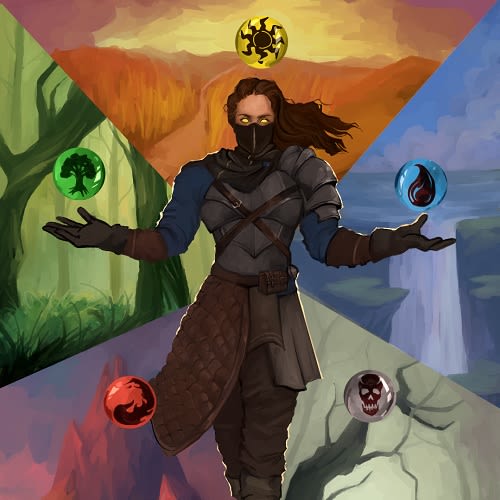Magic's trying a new publishing model! Starting with Dominaria, the storyline is going to be written by established freelance authors! This is different from the old model, where the Creative Team wrote the storyline. It's the same as the OLD old model, though, where freelancers wrote the storyline. Except the bits that were by the Creative Team. Aside from the freelance period before that, anyway.
Turns out that after 25 years, Magic's had plenty of time to explore a number of different storytelling methods, publishing models, platforms, media, authorship paradigms . . . really, practically anything Wizards of the Coast could try, it's at least explored, even if the projects were never finalized.
Of course, these various attempts haven't all gone well. Most of the eras of Magic publishing only lasted a scant few years before something or other was rebooted, reworked, or internally reorganized. How long will the new paradigm last? It's impossible to say for certain . . . but the history of Magic's publishing eras might give us some clues.
Prelude: A Spark
In August of 1993, Limited Edition Alpha introduced our world to the world of Magic: The Gathering for the first time.
Well, to whatever extent you count Alpha as having a "world", that is. The first Magic novel was a year off, and the first Magic expansion in the intervening time was to focus on the Arabian Nights, creating weird continuity issues for years to come. There are hints at an extended world, and Richard Garfield had some sense of what a wizard duel should be like and even, at least by the publishing of "Roreca's Tale," of what a Plane and a Planeswalker was, but the multiverse was still pretty nebulous. This was the era that gave us cards like Nebuchadnezzar, Frankenstein's Monster, and, you know, all of Arabian Nights.
The Upside
This is Magic's most overtly auteurist period, as far as I can tell. The storyline in these days was conveyed through the cards and the cards alone, but often had a ton of thought put into it. Each individual set and setting had its own particular mechanical, flavorful, and narrative mood. Often, the cards in these periods each had their own developed worldbuilding. Homelands, for example, might be best experienced through the details of the Homelands Document which, astonishingly, provides fairly lengthy descriptions of every single card. While sometimes the flavor was a bit rough around the edges, Magic owes a ton to this early period of the storyline, and I don't think that we've seen anything quite like it since.
The Downside
The downside to this was, ironically, that the cards could not contain the full breadth of information generated for them. It would be many years before the Brothers' War was told in full, most notably. All the remarkable information in the Homelands Document or the drafts for the Brothers' War could only be hinted at in flavor text.
Worse, developing sets based entirely on every little story moment led to awkwardly balanced products that were overwhelming to create. 400 card sets simply couldn't be tied to "the same specific plotline." (Hold on to that notion, by the way. It's gonna come back.)
The storyline of Magic was born with the cards. It could not remain with the cards exclusively.
Era 1: Pre-Revision
A year and a month after the release of Alpha came Arena, Magic's first novel, hitting the scene between The Dark and Fallen Empires. Arena wasn't published by Wizards of the Coast -- no Magic content would be for another four years. Instead, it and the series of books that followed were published by HarperPrism. Additionally, a company called Acclaim began publishing Magic comics.
This was a bit of an odd period for the storyline, because not only were these things being published out of house, they were being written mostly by freelancers new to Magic's world. The novels were wide ranging in focus and, surprisingly, largely stayed away from the sets themselves, opting to focus instead on other areas of Dominaria and the wider Multiverse.
The Upside
This freedom in publishing meant that this is one of the most wide-ranging and diverse periods of Magic's history. Not only do stories from this period cover various contemporary sets, they also range far out through Magic's potentially infinite setting. It also gave us, intriguingly, a sense of a world where the players might not be straightforward heroes. Drawing on a longer tradition of antiheroes, from the first HarperPrism novels the power of Planeswalkers walks a knife edge between wish fulfillment and horror. That alone doesn't necessarily make Prerevisionist stories Literary, but it is an intriguing point to build on, one that the Artifacts and Ice Age novels will lean heavily on later.
The Downside
With freedom came confusion. Already in this period there's some strangeness about what a Planeswalker's powers really are, what Dominaria's timeline was, and how various storylines should interact. WotC didn't have a lot of direct control in this period, though they did have a team dedicated specifically to continuity. It was also not completely sustainable. Acclaim's comic line petered out due to lack of sales after a few years, and ambitious projects like the coffee table book Encyclopedia Dominia never saw the light of day. Eventually, in 1996, HarperPrism's contract with Wizards was up. It was time for Wizards to bring the storyline home for the first time.
Interlude: Mirage
Poor Mirage. I feel like I've been playing the "isn't it interesting how this fictional narrative runs parallel to the production realities of the storyline" game a lot lately, and I don't want to become a one trick pony, so instead of doing that here I'll just say:
Jamuraa sure does end up falling into holes in time a lot, huh?
. . . Too soon?
Mirage fell between the end of the Acclaim and HarperPrism stories and the Weatherlight Saga. It had a story, but we've never seen it fully play out. It fell through the cracks again later as the supplementary novels only managed to cover Ice Age and Legends before they, too, got the axe.
The Upside
Mirage remains an amazing set and setting that benefited both from the daring of the Prerevision era and the tighter plotting and design work of the new Weatherlight era. And luckily, we can still follow the detailed narrative today.
The Downside
One of the most interesting stories in Magic, and one of its most groundbreaking in terms of representation, will probably never be told in a fully fleshed out novel form. At least, with any luck, Teferi's figured out something to do for Zhalfir in the last 60 years since it got lost in a phasing accident.
Era 2A: The Weatherlight Saga
1997 was a bust as far as Magic novels were concerned, but what emerged from that year of dormancy was a storyline that had undergone a revision. The Revision. Magic's novels were to be published in-house, and continuity was getting prepared for the first of the new in-house stories: the Weatherlight Saga and the story of Urza Planeswalker.
Everything before the Revision was, and still is, treated as canon unless explicitly contradicted . . . but there were some notable contradictions pretty soon out of gate. Like, Yawgmoth was no longer a Planeswalker, for example. Urza was, but that was because he had this new invention called a "Spark" -- which you needed to have in order to ascend. You couldn't just pull a Garth One-Eye and jump on a big pile of mana and bump up to 'walkerhood anymore. (Also "big pile of mana" really didn't make much sense as a phrase anymore.)
Additionally, the storyline now fit the sets, real closely. Each block had a set of novels that went along with it. That's not to say there weren't side stories. We got several trilogies of such side stories to fill in (and Revise) what was now considered "Pre-Revision" storylines. The Ice Age comics, for example, were revised by Jeff Grubb into The Gathering Dark, The Eternal Ice, and The Shattered Alliance. But the real big deal was the start of continuous storytelling in the form of the Weatherlight and Artifacts Cycles. Spanning many books, and written to closely correspond to events printed on the cards, this was Magic's first real step into treating its storyline as a sustained, serial narrative that we were all supposed to follow for many years in both cards and novels.
The new model balanced the control of publishing in-house with the use of a stable of freelancers that could be used to share the work and offer unique perspectives. The result, early on at least, was a remarkable explosion of storyline materials. 1998 had The Brothers' War, Rath and Storm, and Planeswalker, launching the Weatherlight and Artifacts cycles, and 1999, astonishingly, saw the publishing of The Thran, Time Streams, Bloodlines, the Ice Age novel The Gathering Dark, the anthology The Colors of Magic, and the comic Gerrard's Quest.
I believe these were all written, for the most part, by freelancers, though I'm a little hazy about the specific relationship between folks like Scott McGough and J Robert King to the internal storyline team. At the very least, they were written with close attention from the internal team -- they had to be, as the next few years of Magic's card production would see a large number of cards fit the "same specific plotline" of the Weatherlight and Artifacts sagas, individual cards displaying many specific moments from the novels.
The Upside
There was a LOT of story published in this period, and a lot of it was very good. The fact that Magic HAD a story was impossible to miss. It was plastered all over the cards! Anchored by a recurring cast of characters, this story ranged to some of the strangest worlds fantasy has to offer. Magic's always had a touch of the Weird, of course, but the storyline here had an opportunity to explore the inverted mountain of Mercadia, the flowstone wastes of Rath, and the wild dichotomies of Phyrexia and Serra's Realm through the eyes of protagonists Gerrard and Urza.
The scale of these stories is remarkable. This is a story that spans 4000 years and multiple universes. Magic had played in this territory before, to be sure, but now, with multiple years worth of plot threads and the ability to follow several characters -- Urza, Gix, and Yawgmoth himself most notably -- across that deep time, Magic could fully capitalize on its infinite setting. The transformation of the Thran into Phyrexians could be mirrored across the centuries (and several years of story) with Urza's own seduction by Yawgmoth. Or, writing in parallel, Urza in the Artifacts saga could be mirrored by Freyalise in the Ice Age novels, one carelessly starting an ice age, one carelessly ending it. Not only were these stories good, they were part of an interwoven whole, or so it felt.
The Downside
By the end of the Weatherlight Saga people were real sick of Gerrard.
The thing was, the dude was on a lot of cards. Like a LOT of cards. Those cards weren't in any kind of coherent narrative order for players, either, or in a format that lent itself well to character development. Most of them were just quips, really.
And the novels, well . . . the novels had their ups and downs. This period produced Planeswalker, one of my favorite fantasy novels full stop. It also produced some deeply, deeply weird stuff. As the climactic battle in Apocalypse rages on, for example, the planeswalker Commodore Guff (his name a play on Magic author Scott McGough) argues metatextually with several other 'walkers about whether or not the Weatherlight's victory makes narrative sense. At one point he declares Captain Sisay to have been a much more interesting character than Gerrard, anyway. It was a profoundly strange way to wrap up a multi year franchise saga. (So if you've been complaining about The Last Jedi, consider: shut up.)
The very nature of the multi-year saga model also increasingly ran into problems. Some of these issues are part of the broader post-Revision, pre-Mending era, which largely followed the same publishing model with one major, significant change in the middle. (Tune in next week for THOSE issues.) But the Weatherlight Saga in particular suffered from changing authors and changing priorities. We've only gotten glimpses at Mark Rosewater's original plans for the Weatherlight, but they did not, it seems, much resemble the conclusion in Apocalypse.
By the time Apocalypse rolled around the cracks were showing in the whole experiment. Yawgmoth's invasion plans seem to have suffered the most from garbled rewriting, as the invasion plan set up in Tempest, where the entire world of Rath would overlay onto Dominaria (still a stunningly unique and original device), was basically rendered moot by Yawgmoth himself just sort of waltzing through a portal as a giant death cloud of Black mana and overtaking the whole world, killing and resurrecting everything at a touch. Trying to keep a dozen story threads straight, from several years worth of plots, seems to have resulted in a somewhat garbled final plan . . . that, or maybe Yawgmoth, Urza, Gerrard, and basically everyone else involved in the war were all just real lousy tacticians across the board.
Internally, Wizards of the Coast made the determination: after Apocalypse, the publishing model would remain the same, but the nature of Magic's storyline and its relationship to the cards had to radically change.



























